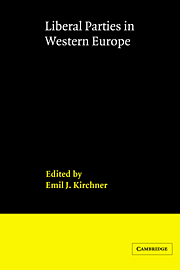Book contents
- Frontmatter
- Contents
- List of tables
- List of diagrams
- List of maps
- Notes on the contributors
- Preface
- 1 Introduction
- 2 Between left and right: the ambivalence of European liberalism
- 3 Two roads of Italian liberalism: the Partito Repubblicano Italiano (PRI) and the Partito Liberale Italiano (PLI)
- 4 The FDP in the Federal Republic of Germany: the requirements of survival and success
- 5 Great Britain — social liberalism reborn?
- 6 Liberalism in France
- 7 Liberal parties in the Netherlands
- 8 The Belgian liberal parties: economic radicals and social conservatives
- 9 The Freiheitliche Partei Österreichs: protest party or governing party?
- 10 The Swedish Liberal Party: The politics of unholy alliances
- 11 Liberalism in Denmark: agrarian, radical and still influential
- 12 The Norwegian Liberal Party: from political pioneer to political footnote
- 13 Liberal parties in Finland: from perennial coalition actors to an extra-parliamentary role
- 14 Liberal parties in Switzerland
- 15 The Luxemburg Liberal Party
- 16 Identifying liberal parties
- 17 Ambivalence revisited: an analysis of liberal party manifestos since 1945
- 18 Transnational links: the ELD and Liberal Party Group in the European Parliament
- 19 Western European liberal parties: developments since 1945 and prospects for the future
- Index of political parties
- General index
7 - Liberal parties in the Netherlands
Published online by Cambridge University Press: 16 November 2009
- Frontmatter
- Contents
- List of tables
- List of diagrams
- List of maps
- Notes on the contributors
- Preface
- 1 Introduction
- 2 Between left and right: the ambivalence of European liberalism
- 3 Two roads of Italian liberalism: the Partito Repubblicano Italiano (PRI) and the Partito Liberale Italiano (PLI)
- 4 The FDP in the Federal Republic of Germany: the requirements of survival and success
- 5 Great Britain — social liberalism reborn?
- 6 Liberalism in France
- 7 Liberal parties in the Netherlands
- 8 The Belgian liberal parties: economic radicals and social conservatives
- 9 The Freiheitliche Partei Österreichs: protest party or governing party?
- 10 The Swedish Liberal Party: The politics of unholy alliances
- 11 Liberalism in Denmark: agrarian, radical and still influential
- 12 The Norwegian Liberal Party: from political pioneer to political footnote
- 13 Liberal parties in Finland: from perennial coalition actors to an extra-parliamentary role
- 14 Liberal parties in Switzerland
- 15 The Luxemburg Liberal Party
- 16 Identifying liberal parties
- 17 Ambivalence revisited: an analysis of liberal party manifestos since 1945
- 18 Transnational links: the ELD and Liberal Party Group in the European Parliament
- 19 Western European liberal parties: developments since 1945 and prospects for the future
- Index of political parties
- General index
Summary
liberal parties in the netherlands defined
Two Dutch parties can legitimately claim to be part of the liberal famille spirituelle, the Volkspartij voor Vrijheid en Democratie (People's Party for Freedom and Democracy, or VVD in the Dutch acronym) which adopted its present name in 1948 and which has been a member of the Liberal International since 1960, and Democraten '66 (or D'66 – recently renamed D66 without apostrophe), which, established in 1966 as a party of radical reform, consciously sought to break the hold of traditional class and religious alignments in Dutch politics in favour of a far going programme of institutional reform.
Of these two parties, the VVD undoubtedly has the older and better title. The 1948 party grew from the Partij van de Vrijheid (Freedom Party) which was established in 1946 as a new incarnation of the pre-Second World War Liberale Staatspartij De Vrijheidsbond. That party in turn had been formed in 1921 to collect a number of different liberal and other parties which had developed side by side in a period of limited franchise and a district system before the First World War, and in the aftermath of that war. In the nineteenth and early twentieth centuries the liberals had regarded themselves (and had been regarded by others) as very much a dominant force in Dutch politics. They had represented the cause of constitutional reform – which had led in 1848 to a comparatively early breakthrough of responsible parliamentary government in the Netherlands, under a constitutional revision which was very much the work of a liberal Professor of Constitutional Law, Johan Rudolf Thorbecke.
- Type
- Chapter
- Information
- Liberal Parties in Western Europe , pp. 151 - 177Publisher: Cambridge University PressPrint publication year: 1988



